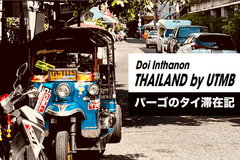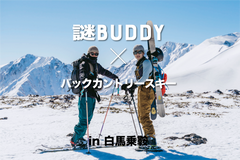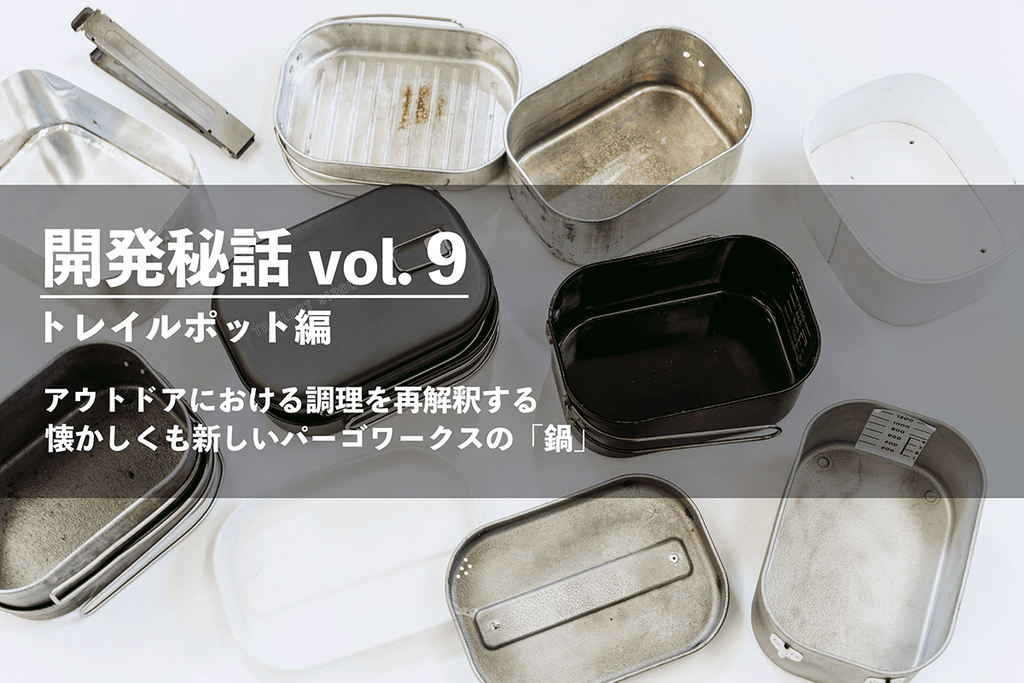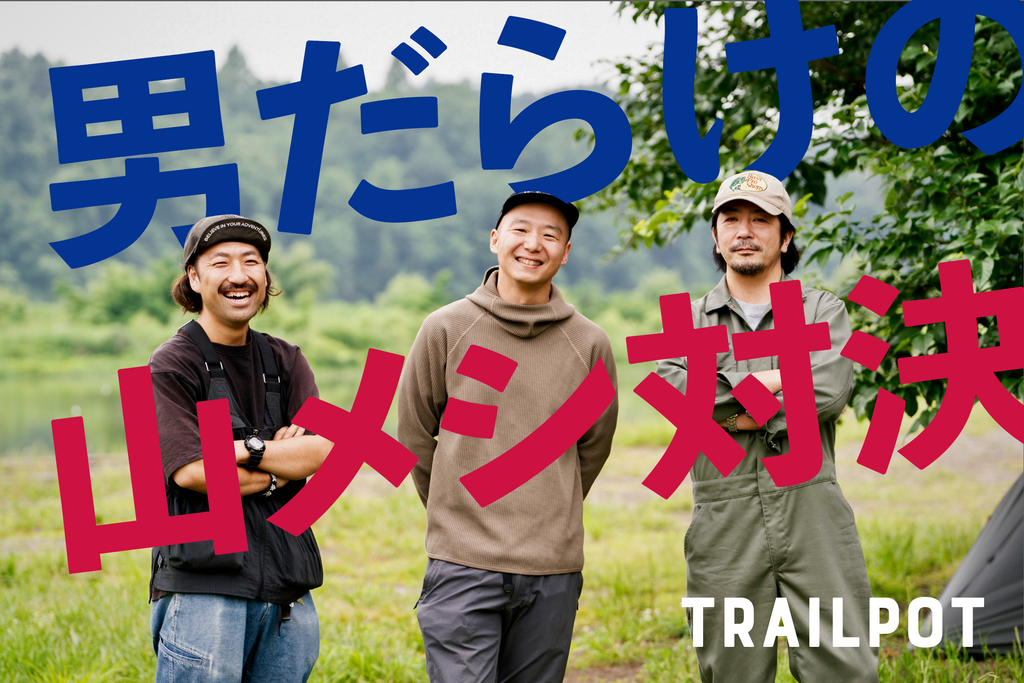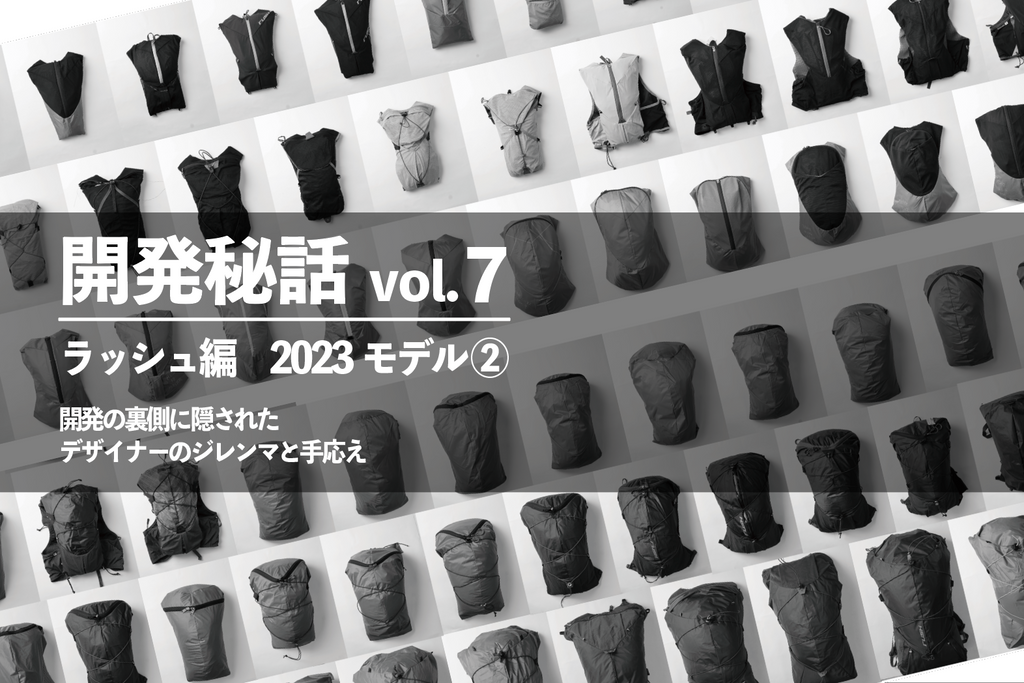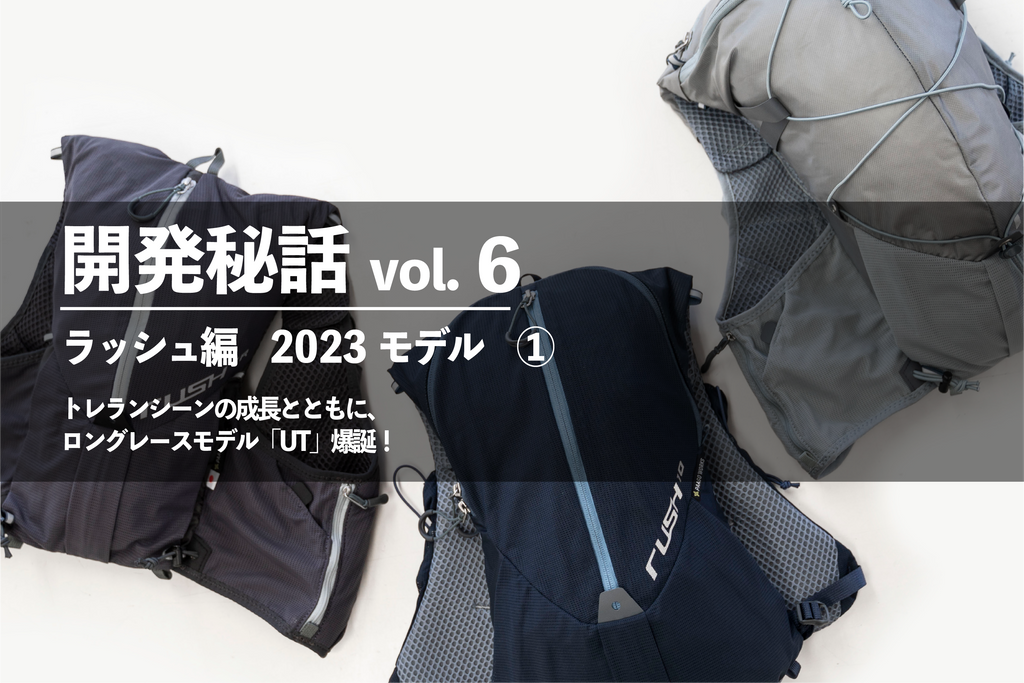MAGAZINE
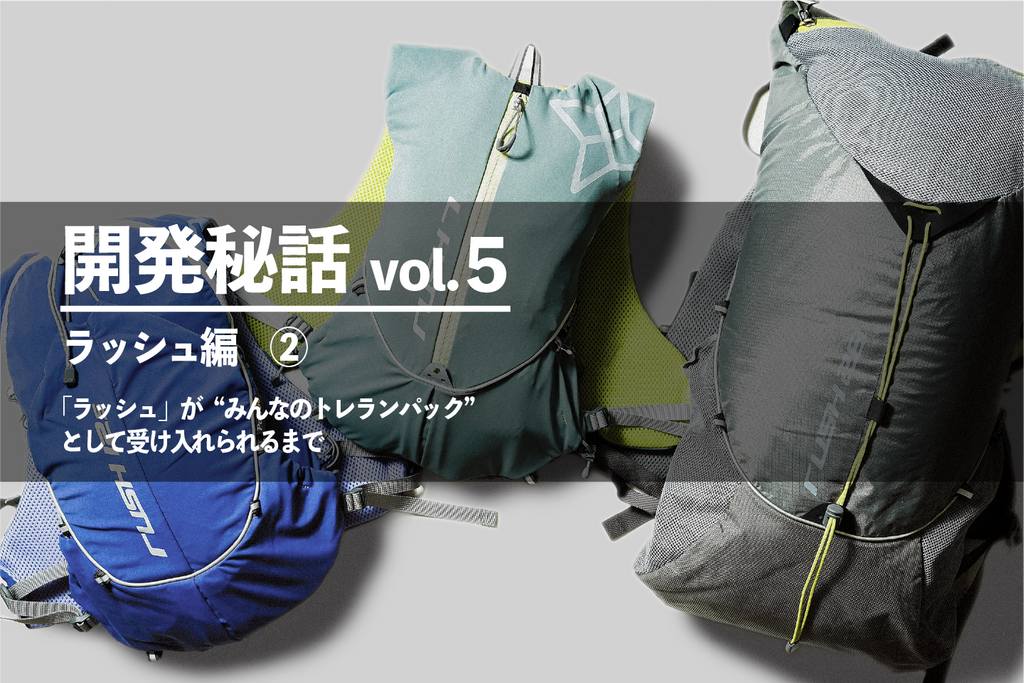
Product History vol.5 Rush Series (Part 2)
Until "Rush" is accepted as "everyone's" trail running pack
Product "Rush" representing Pergo Works. In the previous installment, we talked about designer Toru Saito's impressions of the adventure racing and mountain racing scenes before the brand was born, and the "journey junkie" developed as an item for the predecessor brand. And this time, "Rush", which became the foundation of the current model, is finally here. Let's talk about the trail running scene around 2014 when "Rush" appeared, and the back side of development.

―Last time, we asked you about the eve of “Journey Junkie”. I would like to ask why you came up with the trail running pack "Rush" while you launched Pergo Works and developed and expanded bags such as "Pathfinder" and "Focus".
First of all, I would like to touch on the trail running culture of the time. The brand was launched in 2011, and the UTMF was held for the first time in 2012, the following year. Actually, about 10 years ago, trail runner Tsuyoshi Kaburagi challenged the UTMB on the NHK program "Gekisou Montblanc". A document was aired. I think that this work changed the scene completely. I was surprised to see that too. "It's really cool!" For a long time, I didn't feel like trail running, but this "Gekisou Montblanc" pulled me back. In fact, there are many people like that, and those who started running after the earthquake and those who were doing outdoor activities were inspired, and I felt that they wanted to participate in overseas races, 100-mile races, and so on. was
Until then, it was like Hasetsune, and it wasn't cool. However, there were also people who didn't do outdoor activities and who said, "Training sounds interesting." I think surfing, soccer, and futsal were common. As a result, a new wind began to blow in the scene.
Then, I started to think that I wanted to enjoy trail running more and play more, and I started thinking that I wanted to make things as Pergo Works. caught fire. The brand Pergo Works started with chest bags, but since I started it as a place where I could make what I wanted to make, I thought it would be nice to make a trail running pack. I think people around me were surprised. This is the first stage or background before making "Rush".
―Nowadays, the culture of trail running has taken root, and there are many shops and media outlets. What was it like back then?
I think the market has changed. A store specializing in trail running has opened, and it has begun to transmit the importance of culture, community, and ideas rather than sports. I wonder if it was just crossing the culture of UL, holding a workshop to make and run a wallaci, and spreading vegan running.
Then comes fashion. Garage brands that make trail running packs and other items have also emerged, and a unique Japanese style has emerged. I think the Japanese trail scene originally started with European style. Gradually, American culture entered the scene, and although it gave a stereotyped impression, people wore shorts, sunglasses, beards, and glasses, and drank craft beer.
The difference from the late 90's to the 2000's was the presence of SNS. Individuals began to post their own games and practices, and the number of friends expanded rapidly. I think the peak was around 2015. That way, you don't want to be photographed looking ugly, and your fashion will become more sophisticated. Your sense of beauty has changed.
Regarding the development of the all-important "Rush", I wanted to create a product that perfectly matched that trend, but as the scene grew, I was also worried that if anything became popular, the gap between high-end and low-end would widen. and the entry level will be eliminated. It's the same with mountains, but if there's an atmosphere like you can't do it unless you have good equipment, it's hard to get started.
Originally, I thought that Pergoworks should be a brand for everyone, and I strongly wanted to create a trail running pack that could be used by a wide variety of people. What's more, the so-called entry level pack didn't exist yet in the world of trail running.
―You said you could see the direction, or rather the concept, of the Pergoworks trail running pack.
Salomon's best-type trail running pack was the benchmark at the time. When I saw it, I thought, "Oh, I made something like this in Journey Junkie a long time ago." But can a beginner carry the trail pack correctly? I had a question. Although it was an excellent product, it was difficult for people who had just started trail running to master it.

Cool though. However, if people think of it as a sport that uses difficult tools, the threshold for trail running will rise, and the true enjoyment of running in the mountains will be lost. From a new person's point of view, it feels rather lame.
So, "Rush 7" and "Rush 12" appeared. The target is trail running as an extension of daily life, even if it is not for everyday use. It's not a design for enjoying the extraordinary, like going to a summer ski resort like the European Alps, but for the Japanese scene.


As simple, easy, and cool as possible. The material is made of elastic lycra, and the feature is that the pockets are flat. There is no gusset, so the finish is quite neat. The main body is also compact if there is little luggage, and the fabric stretches even if it is full, so it has a wide range of support. It is also attractive that it fits the body because it is made supple.


As a particular part, the form is put in the harness. Many models of racing vests have a flimsy harness that hurts the shoulders, but the foam reduces the burden.

As a designer, I was particular about making sure that all the stitches on the early models were sewn inside so that the stitches could not be seen from the front. I wanted the design to be clean. However, the fact that the main body and the harness were sewn inside was a design that made the factory cry. I'm going to have a hard time with this later.
The characteristic of the fabric called Lycra is that it is flexible, so it will fit your luggage firmly, but the disadvantage is that it will sway. This design was born to prevent that, but first of all, we adopted a center zipper that also prevents the fabric from stretching in the vertical direction. The V-shaped line is for supporting the load from the side. There is also a belt on the inside where you can't see it, and it stops the load. It is characterized by a design that stretches horizontally while suppressing movement in the vertical direction.

As for development, we got to the answer relatively quickly. However, I had a question, "What would it be like to actually use it?" I gave it to the runners of the trail running team and got their feedback. It feels like I collected those opinions and brushed them up.
Regarding the development of "Rush", it was my first time to make it, so I thought I could do anything. Even if it wasn't accepted, I wanted to make something that other people didn't make, and I thought it would be nice if I could propose what I wanted first. There are many products that are more functionally superior, but I think the trail running pack called "Rush" was an outstanding hit product in that entry people could use it without worrying.
―The production system is also different from the conventional chest bag. The fabric and structure are different, so were there any difficulties during the manufacturing stage?
After all, the production efficiency is bad because everything is sewn inside. It should be a backpack with only 7L, but it takes a lot of work anyway. It's not a common process for a factory, and the material Lycra is a flexible fabric. Lycra is troublesome and has the property of curling when cut. Normally, I would stack about 100 cut pieces and bring them to a sewing factory, but that would end up being tattered when they arrived. Moreover, it is difficult to understand the front and back, and management is very difficult. So I think the factory had a lot of trouble.

By the way, I bought the fabric in Japan and sent the rolls to overseas factories. The reason I was doing this was because the quality of locally procured Lycra-like fabrics was not good. So is the elongation rate, durability, and solidity. I was particular about what I could arrange in Japan.
―Did you have any real feelings about the scene after launching “Rush”?
I really felt it. Because users gather when trail running goes to the race. If you go to the starting line, you can see the users. I've never had that experience with any Pergo product before. I've seen them in the mountains, but they don't gather like they do in races.
So when I went to a big race the year after it went on sale, I was surprised at the number of “Rush” users. There are many entry-level players, and that is exactly what we were aiming for. Also, I have the impression that people with high sensitivity from the gear perspective also used it.
Hasetsune (Japan mountain endurance race - Tsuneo Hasegawa cup) and Shinetsu Gogaku (Shinetsu Gogaku Trail Running Race) go to support every year, and count how many people are using it at the start, and the number of "rush" users increases year by year. I could feel it going.
At that time, Pergoworks also posted on SNS quite frequently, so some people may feel nostalgic. I went to races almost every week and was allowed to take pictures of the runners and upload them, and I had a close relationship with the users. Feeling that the promotion was riding on the excitement of SNS. This is the era too.
“TRY ON RUSH”, which can be fitted at a standard race venue, started around 2015. Actually, I had never opened a race stall or an event stall until then, and I was just participating or cheering. By setting up our own booth at the venue, we were happy to receive direct comments from users. Lectures on how to use it and answers to user questions. I used to do this at local races, and I used to post on social media where I was going to do it, and it was a good memory for us to run together.
―After that, a large-capacity model called “Rush 28” appeared, but what was behind that?
I developed "Rush 28" so that I could participate in OMM (laughs). I believe the first event was held in Japan in 2014. I wonder if it was just the timing when trail running races began to diversify. What was important during development was the same good fitting as the previous rush series. And without extra functions, it looks simple.
A new feature of the Rush 28 is an opening that can be opened quickly, and when closed, it snaps to the side of the body to increase stability. The larger the backpack, the greater the shaking when running, so by combining the mechanism of the top stabilizer and the mechanism of the opening, we succeeded in creating a simple yet highly effective design.
At the time, there were many backpacks for adventure races that didn't have a top stabilizer, but that would still shake. Also, the ones based on climbing packs were very simple to make, so I couldn't say that the fitting was good.
If it's a backpack for mountain climbing, you can solve it by attaching a top stabilizer. However, the trail running pack does not have a frame on the back, so the main body warps and is ineffective. This was solved by connecting the fabric on the front and the shoulder belt. However, the stabilizer doesn't work without a load, so adding compression to the front helps maintain stability even when the load is light.
The word “fast packing” has just spread, and more and more people are practicing it. I thought I finally had a "running backpack" that I could use. By the way, 28L is the size that fits the equipment when I go to OMM. Since the regulations changed later, it is only here that we updated to the 30L model in response to that.

―The Rush 30 is now the number one backpack you often see at OMM race venues. The current "Rush" series is an improved second generation. I don't think the basic design has changed, but what about changes and updates?
With the release of "Rush 7" and "Rush 12", we were able to connect with the trail running scene. Through events and SNS, I felt the excitement of the scene itself, and while listening to the thoughts of various users, I began to think, "Let's make things for these people."
That's why when we updated the Rush, we needed to evolve it into a better model. At the heart of it all, for better or worse, was the lycra fabric used.
Because of its elasticity, there were many users who packed their things to the limit more than they expected. The fabric stretches and thins so that the luggage can be seen through. Also, some said it was hot in the summer. When I hold an event in Hong Kong, the local people say that all the time. "It's cool, but it's hot. Please make it more breathable." So I started looking for another fabric.

The fabric used in the current model is Darlington mesh. It doesn't have the smooth feel of Lycra, but it's durable, lightweight and breathable. Since the vertical and horizontal stretch rates are different, I thought that if I used it well, I could achieve both stretchability and stability. In fact, the factory has reached the limit of Lycra production and has given up. It is difficult to handle and the productivity is bad. So I think it was destined to change the fabric with this update.

By the way, the basic design concept of the current model has not changed, and there are no major changes in construction. However, the number of staff increased, communication with the store became stronger, and the sales network was strengthened at this time. In other words, the environment surrounding Pergo Works has changed. In addition, the population of "Rush" users themselves will increase, and each of them will steadily improve their level. I felt that both "Rush" and Pergoworks would grow together with the users.
